[ad_1]
Description of the solar light
Several kinds of solar lights exist. The one discussed here will have a plastic bird, butterfly, dragonfly, or flower ornament perched above the light-emitting-diode (LED) bulb at the upper tip of its three-foot hollow metal-rod stem. For support, this rod is stuck into the ground. Also, the light's circular solar collecting panel (containing the photo-cells) is located about halfway down the rod. During the day, this panel must face the sun for maximum recharging.
Its problem
This so-called outdoor night-light can quit working anytime if the outside weather goes from freezing to hot temperatures with lots of rain in between. Yet, its LED bulb and solar collector are fairly durable. So, any immediate failure with this light is usually something else. Its most common problem is the single rechargeable Nickel-Cadmium (NiCad) battery inside the solar panel assembly. This battery will not recharge forever, and it will lose power with time. It must be replaced with a new one. But what kind of battery is it?
Solar battery
Although the solar battery looks like a double-A (AA) battery, it really is not. It is a different kind of battery with the AA shape and size. Its voltage of 1.2-V is slightly less than the 1.5-V of a typical AA. It also yields a lower amperage of 500-1000 milliamps hour (mAh) compared to the 2000-3000 mAh for a real AA. Why the difference?
For one thing, the LED lights require much less power. This lower output also allows the light to run longer, preferably all night. Thus, the first step to fix the problem is to find a package of solar batteries. A package of four NiCad's can be found in many hardware or large department stores for less than $10.
Once found, check the mAh listed on the on their package or on the batteries themselves. Anything between 500-to-1000 mAh works fine. My recent package said 800-mAh. Next, carefully remove the failed light from the ground by grabbing its rod stem at its lower end, and then, find a place to replace its battery.
Disassembly of the solar panel assembly
More than likely, your solar panel will not have a sliding or removable cover over its battery compartment. So, do the following.
- If the panel assembly has an on-off switch, turn it off.
- Find the three small screws on its backside, and remove them with a screwdriver.
- Carefully and gently pull the backside of the assembly partly loose. Its inside wiring is fairly tight; try not to strain or break it.
- Within this narrow working space, locate the spent solar battery. Remove it from its cage while noting which end of the cage is the positive (+) end.
- Insert the new one, making sure its positive end is in the right place.
- Replace the backside of the panel and its screws.
- Turn the panel switch on.
- Test the light in dark room or closet. Often, the new solar batteries are fully charged to start with.
Conclusion. Although this solar light is reasonably inexpensive ($5-15), it can be a disappointment if it quits working at inopportune moments. To save time and money, carefully replace its solar battery instead. For more detailed information on this task, see this website.


